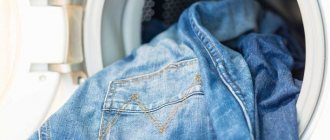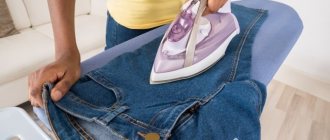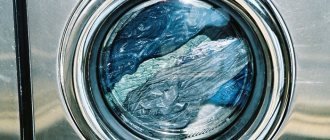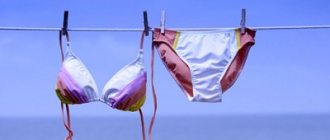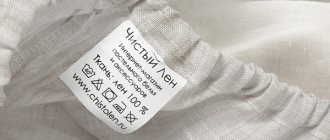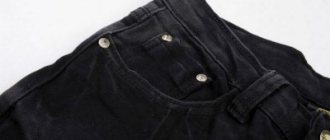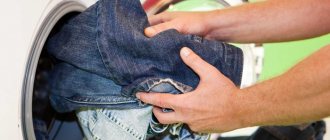Features of denim
Classic denim is made from cotton twill weave. This fabric is very dense, with a characteristic relief, comfortable to wear. Denim is often supplemented with threads with a synthetic base: this adds new properties. Stretch jeans with polyester have excellent stretch and fit perfectly to the figure.
Caring for natural and blended denim consists of a number of rules. The most basic ones are always indicated on the label.
How often to wash
Although no one forbids washing jeans every day, frequent contact with water and detergent will cause the fabric to lose its elasticity and color faster. The less frequently we wash our jeans, the longer they last. But this does not mean that you need to stay in your pants for a whole month, and only then wash off the ingrained layer of various dirt. Washing is always commensurate with wear: worn a little, then washed.
It is better to wash new jeans immediately after purchase. Local stains should be washed by hand in a basin, so as not to spin generally clean trousers in the drum.
Advice A sure sign that jeans need cleaning is a stretched waistband or slightly protruding knees. After drying, the shape will be restored.
General rules
To prevent jeans from fading or becoming deformed, they need to be turned inside out before washing. Before doing this, be sure to check all fasteners (buttons, buttons, zippers). They must be buttoned. Things turned inside out suffer less from contact with the drum. There are no scratches on the metal fittings, and the finishing seams do not wear out.
Stains, if any, must be treated with a special stain remover or improvised means. Decorative leather parts are lubricated with glycerin. It prevents the appearance of small cracks. Pockets are turned inside out and all small change is removed from them.
Pants and jackets decorated with stripes, beads, and decorative elements are washed by hand or in a mesh bag.
What you can and cannot wash with
Denim fabric is dense and heavy and can fade, so it is recommended to wash items made from it separately. If the maximum volume of the drum allows, you can put sports T-shirts, trousers, and other items of the same color as jeans along with your trousers.
Washing rules
For any type of washing, try to use cold, or maximum warm, water. Jeans need to be prepped a bit before soaking or cycling in the machine.
Preparation
Check your pockets and remove anything unnecessary. It is better to fasten zippers and buttons. If you machine wash on the standard cycle, turn the pants inside out so that the front side experiences less friction. Be sure to turn decorated trousers inside out.
If there are difficult stains, for example, grass or berry juice, then wet them with water and soap them with laundry soap. Antipyatin soap for colored laundry works well on jeans.
Wash by hand
Hand washing is a priority if jeans are prone to shedding and contain synthetic threads.
How to wash by hand:
- Dissolve the detergent in a large bowl. The jeans should be completely submerged in water. Temperature - 30-40 degrees.
- Soak the prepared pants for 40-50 minutes.
- “Massage” your pants with light movements, paying attention to the seams, pockets, knees, waistband - those places that get dirty the most.
- Drain the solution and rinse thoroughly in running water.
- Squeeze gently. You can twist it, but moderately.
- Shake off the moisture, straighten your pants and set them to dry.
Machine washable
It is important what mode the jeans will be washed on. Consider the composition of the fabric.
How to wash denim in a machine:
- Choose manual or delicate mode. “Cotton” at 30-40 degrees is suitable.
- Reduce the spin speed to minimum if you want to save your pants.
- To avoid overloading the drum, do not wash more than 3-4 pairs at a time. Cotton jeans become heavy when wet.
- Don't neglect additional rinsing.
- Avoid machine drying.
How to wash jeans
For hand washing, it is advisable to select products based not only on their cleaning properties, but also on their effect on the skin of the hands:
- Jeans can be washed with regular laundry soap. It cleans fabric well of dirt and copes with complex organic stains on clothes. It is made from natural fats of animal origin, which is important for the skin of the hands.
Laundry soap effectively removes dirt during hand washing and cares for the skin of your hands.
- Special laundry detergents made from ingredients of plant origin are safe for health. It’s good if the label contains a mark indicating compliance with SAN PIN standards.
Synergetic is a safe product that can even be used for washing children's clothes.
- It is convenient to clean jeans with a brush. For dense fabrics, a stiffer one is suitable, but for thin and elastic ones, it is better to take a brush with soft bristles. You can use a household sponge.
- If the product has an unstable color, the last rinse should be done in a vinegar solution: 1 tablespoon per liter of water. This will help preserve the color.
Any liquid detergent is suitable for machine washing. They dissolve well in water and are easier to rinse without leaving marks on clothes. You can use special gels for washing denim, which are designed taking into account its characteristics.
A special product for denim will protect clothes from color loss and make them soft after washing.
When purchasing liquid detergent, focus on color and smell. Open the cap and check that the liquid is white or neutral in color. The brighter it is, the more unnecessary dyes it contains. A pleasant smell is also a sign of excess chemicals. Manufacturers guarantee frosty freshness or the smell of lemon, but this will not affect the quality of the wash.
Table: overview of detergents for denim clothes
| Name | Manufacturer | Release form, volume | Compound | Characteristics of the product | pros | Minuses | Price |
| Bagi Jeans | Bagi, Israel | Gel concentrate, 1 l. |
|
|
| High price | From 320 rubles |
| Domal Jeans | Domal, Germany | Concentrated gel, 750 ml | Does not contain harsh chemicals |
|
| High price | From 408 rubles |
| BiMax Jeans | BiMax, Russia | Concentrated gel, 1.5 l. | Surfactants and dietary supplements |
|
| After the first or second wash, the color change is not noticeable. | From 464 rubles |
| Dreft Black | Dreft, Belgium | Gel, 3 l. |
|
|
| High price | From 754 rubles |
| Luxus professional |
| Gel, 1 l. | Surfactants and phosphates |
|
|
| From 235 rubles |
| Wellery DELICATE Color | New Chemical Technologies LLC, Russia | Gel, 1 l. | Surfactant, does not contain phosphates and dyes |
|
| Not always on sale | From 220 rubles |
| Amway Home SA8 Black | Amway | Gel, 1 l. |
|
|
| High price | From 1300 rubles |
Video: which product removes dirt better
Typical washing mistakes
Banal laziness or ignorance of the features of jeans leads to minor troubles, and if you are unlucky, then to damage to the pants beyond repair. Don't make these mistakes like other housewives.
Washing with other items
Washing classic blue jeans with white clothes, even at 30 degrees, is a big risk. After such a mistake, housewives take a long time to remove blue stains from T-shirts and shirts.
Wash jeans only with similar fabrics, preferably of similar composition, following the instructions on the labels.
Heat
Washing at 60 degrees or higher often causes jeans to fade, especially if they are black or deep blue.
There is another problem: the fabric shrinks. You risk simply not fitting into your favorite trousers.
Incorrect spin
If you set the washing machine to the most powerful spin, thin jeans may not withstand the load and tear. Reduce speed to avoid excessive wrinkling of the fabric.
Incorrect washing mode
Natural cotton jeans on the “Wool” or “Synthetic” mode may not wash.
Rules for light and dark products
Features of washing white items:
You can use products containing a bleaching component.- You can wash your pants at temperatures up to 60 degrees, if there is an urgent need for it.
- When hand washing, careful consideration and rinsing of the seams is necessary. If this is not done, gray or yellow streaks will remain on your pants.
Features of washing dark:
- do not use formulations containing bleaching granules for washing;
- to preserve color, you can use washing powder for black fabrics;
- The maximum washing temperature is 30 degrees.
You need to wash white and dark jeans separately - this is the most important rule that cannot be broken. You can learn about the rules for washing black jeans from this article.
How to dry properly
The final stage of washing is proper drying. For most fabrics, natural drying is a priority, and denim is no exception.
All drying rules:
- Straighten out any creases.
- Hang your pants or place them on the dryer.
- Do not dry on a radiator or in a dryer. Over-drying harms the fibers and makes them brittle. For the same reason, ironing is harmful to jeans.
- To prevent your pants from fading in the sun, turn them inside out if you dry them outside in the summer.
Changing jeans size
We use all the tips in reverse to reduce stretched jeans. Tricks will also come in handy for those who have lost weight by 1-2 sizes, but do not yet have the opportunity to update their wardrobe.
Shrinkage
Wash your jeans in a machine at 60 or even 90 degrees. The more cotton in the composition, the higher the likelihood of shrinkage. A radical method is boiling in a saucepan, but this is only suitable for the most durable denim.
Stretching
To stretch pant legs, work with the fabric while it is wet. Simply secure the waistband and give the bottom a good tug. Leave to dry in this position, you can additionally secure the pant legs.
Another way is to steam your jeans well and put them on yourself.
Do I need to iron it?
If you hang wet jeans from your waistband, they will straighten out on their own under their own weight. This eliminates the need for ironing.
When it is still necessary, for example, in order to soften a thing, adhere to the following recommendations:
- Do not iron dry fabric. The pants should remain slightly damp. If time is lost, they can be moistened using a spray bottle.
- The product can only be ironed from the reverse side.
- It is recommended to set the iron temperature to 150 degrees. The thinner the fabric, the lower it should be.
- To prevent pocket marks from remaining on the trouser leg, you need to put a handkerchief in it. First, iron the seams and the back side, then the pockets and the front surface of the product.
After ironing is completed, the jeans should be allowed to cool so that they are fixed in the desired position.
Read about how to iron jeans here.
If it is not possible to wash or washing is prohibited
It is worth listening to the opinion of famous denim designers, such as the creator of the Levi's brand, Levi Strauss: to make jeans last for several years, wash them once every 2 months. There is no point in taking this advice to the point of absurdity, because today the fabrics of jeans vary greatly in composition, and the thing is so comfortable that you want to wear it every day. But you can take note of some tricks that will reduce the number of washes.
Dry cleaning
Folk remedies for dry and wet cleaning are salt, soda, hydrogen peroxide, ammonia, vinegar solution and others. Can be used without water. To remove traces of the product, use a vacuum cleaner, an alcohol wipe, or simply wait until it dries.
Local wet cleaning
Stains can be treated with soapy water, dish soap (it effectively removes greasy marks), or soda slurry. Use a soft sponge or brush, be sure to rinse off the product with water.
Ventilation
An alternative to frequent washing is long-term airing. This method will help when there are no visible stains on the jeans, but body odor remains. The smell on the balcony will disappear within 24 hours.
